External links
- Hymns of The Church of Jesus Christ of Latter-day Saints, #292, "O My Father" - full text of the hymn
- Interactive music player version with hymn typeset as a sheet music
- Free MP3 download
| "O My Father" originally "My Father in Heaven" | |
|---|---|
| Hymn | |
| Written | October 1845 |
| Text | by Eliza R. Snow |
| Melody | set to "My Redeemer" by James McGranahan |
| Published | 15 Nov 1845: Nauvoo, Illinois |
| Publisher | Times and Seasons |
"O My Father" (originally "My Father in Heaven", [1] also "Invocation, or The Eternal Father and Mother") [2] is a Latter-day Saint hymn written by Eliza R. Snow, who felt inspired to write the lyrics after Joseph Smith had taught her the principle of heavenly parents. [3]
Although references to a Heavenly Mother by church leadership have occurred every few years [4] since Smith first taught the doctrine, the hymn is significant in terms of Mormon theology in that it is perhaps the most prominent and well-known reference to a "Heavenly Mother" in materials published by the Church of Jesus Christ of Latter-day Saints.
After discussing pre-mortal existence and a sense of belonging to "a more exalted sphere" in heaven, stanza three reasons that if there is an eternal Father there must also be an eternal Mother:
I had learn’d to call thee father
Through thy spirit from on high;
But until the key of knowledge
Was restor’d, I knew not why.
In the heav’ns are parents single?
No, the thought makes reason stare;
Truth is reason—truth eternal
Tells me I’ve a mother there.— Eliza R. Snow [5]
Snow wrote "O My Father" as a poem under the title "My Father in Heaven" in October 1845 in the home of Stephen Markham in Nauvoo, Illinois. The Times and Seasons first published the words on 15 November 1845, more than a year after Smith was killed. [1]
The poetry was later set to the music of another Christian hymn, "My Redeemer" by James McGranahan, [6] and included in Latter-day Saint hymnals, including the current one. When a collection of Snow's poems were published in 1856, this work was placed first in the double-volume set and entitled "Invocation, or The Eternal Father and Mother". [2]
The Adam–God doctrine was a theological idea taught in mid-19th century Mormonism by Brigham Young, a president of the Church of Jesus Christ of Latter-day Saints. Although the doctrine is rejected by the LDS Church today, it is still an accepted part of the modern theology of some Mormon fundamentalists.
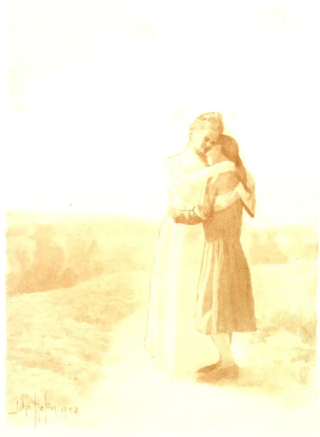
In the Latter Day Saint movement, Heavenly Mother or the Mother in Heaven is the mother of human spirits and the wife of God the Father. Collectively Heavenly Mother and Father are called Heavenly Parents. Those who accept the Mother in Heaven doctrine trace its origins to Joseph Smith, founder of the Latter Day Saint movement. The doctrine became more widely known after Smith's death in 1844.
Eliza Roxcy Snow was one of the most celebrated Latter Day Saint women of the nineteenth century. A renowned poet, she chronicled history, celebrated nature and relationships, and expounded scripture and doctrine. Snow was married to Joseph Smith as a plural wife and was openly a plural wife of Brigham Young after Smith's death. Snow was the second general president of the Relief Society of the Church of Jesus Christ of Latter-day Saints, which she reestablished in Utah Territory in 1866. She was also the sister of Lorenzo Snow, the church's fifth president.
In orthodox Mormonism, the term God generally refers to the biblical God the Father, whom Latter Day Saints also refer to as Elohim or Heavenly Father, and the term Godhead refers to a council of three distinct divine persons consisting of God the Father, Jesus Christ, and the Holy Ghost. However, in Latter Day Saint theology the term God may also refer to, in some contexts, the Godhead as a whole or to each member individually. Latter Day Saints believe that the Father, Son, and Holy Ghost are three distinct beings, and that the Father and Jesus have perfected, glorified, physical bodies, while the Holy Ghost is a spirit without a physical body. Latter Day Saints also believe that there are other gods and goddesses outside the Godhead, such as a Heavenly Mother—who is the wife of God the Father—and that faithful Latter-day Saints may attain godhood in the afterlife. The term Heavenly Parents is used to refer collectively to the divine partnership of Heavenly Father and a Heavenly Mother. Joseph Smith taught that God was once a man on another planet before being exalted to Godhood.

Apotheosis, also called divinization or deification, is the glorification of a subject to divine levels and, commonly, the treatment of a human being, any other living thing, or an abstract idea in the likeness of a deity.
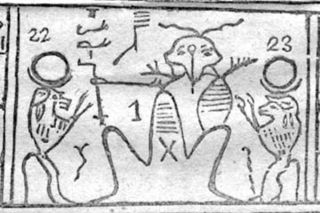
Kolob is a star or planet described in the Book of Abraham, a sacred text of the Latter Day Saint movement. Several Latter Day Saint denominations hold the Book of Abraham to have been translated from an Egyptian papyrus scroll by Joseph Smith, the founder of the movement. According to this work, Kolob is the heavenly body nearest to the throne of God. While the Book of Abraham calls Kolob a "star", it also calls planets "stars", and therefore some Latter Day Saint commentators consider Kolob a planet. The body also appears in Latter Day Saint culture, including a reference to Kolob in an LDS hymn.
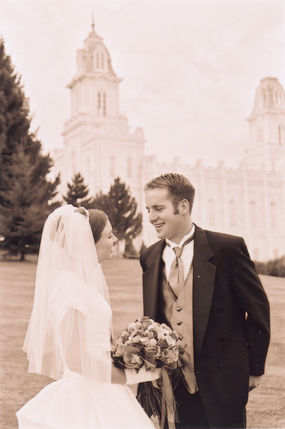
Celestial marriage is a doctrine that marriage can last forever in heaven. This is a unique teaching of the Church of Jesus Christ of Latter-day Saints or Mormonism, and branches of Mormon fundamentalism.
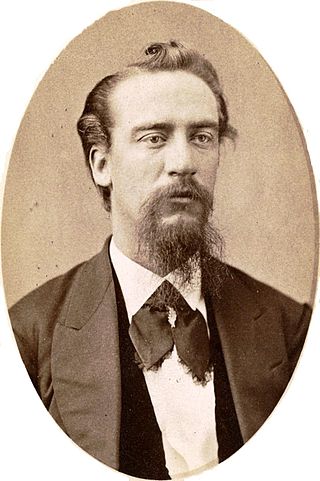
David Hyrum Smith was an American religious leader, poet, painter, singer, philosopher, and naturalist. The youngest son of Joseph Smith and Emma Hale Smith, he was an influential missionary and leader in the Reorganized Church of Jesus Christ of Latter Day Saints. He was born approximately five months after the murder of his father. Joseph told Emma before he died what the child's name should be. From December 1847, David was raised by his mother and her second husband, Lewis C. Bidamon.
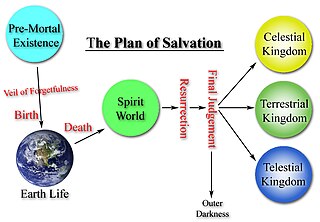
According to the doctrine of the Church of Jesus Christ of Latter-day Saints, the largest denomination in the Latter Day Saint movement, the plan of salvation is a plan God created to save, redeem, and exalt humankind, through the atonement of Jesus Christ. The elements of this plan are drawn from various sources, including the Bible, Book of Mormon, Doctrine & Covenants, Pearl of Great Price, and numerous statements made by the leadership of the Church of Jesus Christ of Latter-day Saints. The first appearance of the graphical representation of the plan of salvation was provided in the 1952 missionary manual entitled A Systematic Program for Teaching the Gospel.
Hymns are an important part of the history and worship of the Church of Jesus Christ of Latter-day Saints.
Jaroslav Vajda was an American hymnist.

Mormon poetry is poetry written by members of the Church of Jesus Christ of Latter-day Saints about spiritual topics or themes. Mormons have a long history of writing poetry relevant to their religious beliefs and to the Mormon experience. Mormon poetry, like Mormon fiction, has experienced different periods throughout the LDS Church's history, including the "home literature" period and the "lost generation." Some Mormon poetry became church hymns.

Mormon cosmology is the description of the history, evolution, and destiny of the physical and metaphysical universe according to Mormonism, which includes the doctrines taught by leaders and theologians of the Church of Jesus Christ of Latter-day Saints, Mormon fundamentalism, the Restoration Church of Jesus Christ, and other Brighamite denominations within the Latter Day Saint movement. Mormon cosmology draws from Biblical cosmology, but has many unique elements provided by movement founder Joseph Smith. These views are not generally shared by adherents of other Latter Day Saint movement denominations who do not self-identify as "Mormons", such as the Community of Christ.
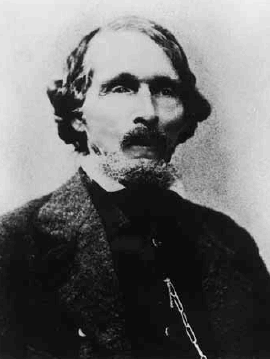
"Praise to the Man" is a poem written as a eulogy in verse for Joseph Smith. The poem's authorship is typically attributed to Latter Day Saint leader and hymn writer William W. Phelps. The poem was composed soon after Smith's death, and was later set to music and adopted as a hymn of the Church of Jesus Christ of Latter-day Saints. It was first published with no directly attached name in the church newspaper Times and Seasons in August 1844, approximately one month after Smith was killed. The hymn is still used in the LDS Church, as number 27 in its current hymnal.

John Jaques was a Latter Day Saint hymnwriter and missionary and an Assistant Church Historian for the Church of Jesus Christ of Latter-day Saints.
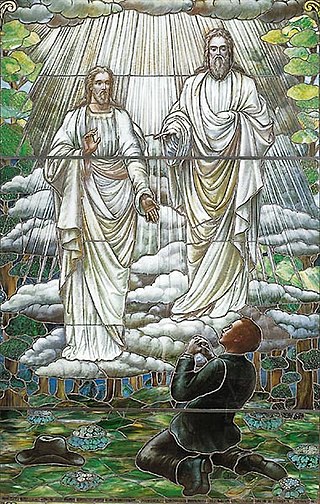
The Church of Jesus Christ of Latter-day Saints focuses its doctrine and teaching on Jesus Christ; that he was the Son of God, born of Mary, lived a perfect life, performed miracles, bled from every pore in the Garden of Gethsemane, died on the cross, rose on the third day, appeared again to his disciples, and now resides, authoritatively, on the right hand side of God. In brief, some beliefs are in common with Catholics, Orthodox and Protestant traditions. However, teachings of the LDS Church differ significantly in other ways and encompass a broad set of doctrines, so that the above-mentioned denominations usually place the LDS Church outside the bounds of orthodox Christian teaching as summarized in the Nicene Creed.
Karen Lynn Davidson (1943–2019) was a Latter-day Saint hymn writer, author, and literary critic. Davidson wrote widely on the hymns of the Church of Jesus Christ of Latter-day Saints and of the Community of Christ.
Heavenly Parents is the term used in Mormonism to refer collectively to the divine partnership of God the Father and a Heavenly Mother who are believed to be parents of human spirits. The concept traces its origins to Joseph Smith, the founder of the Latter Day Saint movement.
The concept of premortal life in the Latter Day Saint movement is an early and fundamental doctrine which states that all people existed as spirit bodies before coming to Earth and receiving a mortal body. In Mormonism's eponymous text, the Book of Mormon, published in 1830, the premortal spirit of Jesus Christ appears in human form and explains that individuals were created in the beginning in the image of Christ. In 1833, early in the Latter Day Saint movement, its founder Joseph Smith taught that human souls are co-eternal with God the Father just as Jesus is co-eternal with God the Father, "Man was also in the beginning with God. Intelligence, or the light of truth, was not created or made, neither indeed can be."